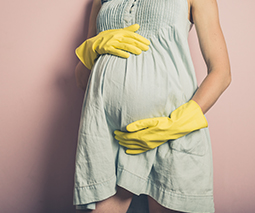Vaginal examinations aren’t the only way to tell how your labour is progressing

Did you know that there is a way to tell how far a woman’s labour is progressing that doesn’t require a vaginal examination? If you didn’t – this fun fact might just blow your mind.
Aptly labelled ‘The Purple Line’, this line runs along a woman’s natal cleft (or in layman’s terms: her butt crack).
The Purple Line
It begins at the anus, and as her labour progresses, it moves all the way up to the top – indicating full dilation. Being informed about this line and watching its movement can equip a woman and her care providers with the knowledge of how things are going without having an intrusive vaginal examination.
This discovery is a fantastic tool to be mindful of – especially because vaginal examinations are not always 100 percent accurate.
Senior Lecturer in Midwifery, Dr Rachel Reed concurs. She says that knowledge of the purple line is one assessment she uses to ascertain how labour is going for the women under her care, and emphasises the importance of observing the whole woman – not just her cervix.
“Based on understanding the physiology of birth and knowing and understanding the individual woman. During labour, I am observing the pattern of labour and the woman’s behaviours … I expect a shift or a change over time. Being a midwife is an embodied experience of ‘being with’ the woman – she ‘tells’ you about progress through the way her body moves, acts, sounds, and her contraction pattern,” says Dr Reed.

What research says about the purple line
In a longitudinal study performed in 2010 on the accuracy of the purple line in labouring women, out of the 144 women observed, 76 percent of them were noted to have the purple line. This means that 109 women were shown to have a physical indicator of labour’s progression through an external observation alone.
The study concluded that alongside other measures, the purple line proved a useful guide for clinicians to assess labour.
What research says about vaginal examinations
Recommendations from doctors on vaginal examinations state that only every four hours is necessary. This is because there are side effects of vaginal examinations related to their incredibly intrusive and often painful nature. There is even evidence to suggest that the vaginal examination itself can have a negative effect on the labouring woman, interrupting her focus and causing anxiety.
With all of this information in mind, women are encouraged to educate themselves and their care providers of the purple line, and not rely solely on cervical dilation as a means of discerning labour’s progression.
After all, a woman is more than just her cervix!
 Need some support to be the best parent you can be? Our Parent School parent coaching experts can help. Click to find out more or book a one-on-one session.
Need some support to be the best parent you can be? Our Parent School parent coaching experts can help. Click to find out more or book a one-on-one session.









